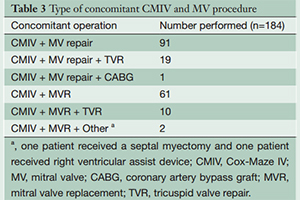Comparison of the stand-alone Cox-Maze IV procedure to the concomitant Cox-Maze IV and mitral valve procedure for atrial fibrillation
Abstract
Background: The majority of patients undergoing surgical ablation for atrial fibrillation (AF) worldwide receive a concomitant mitral valve (MV) procedure. This study compared outcomes of the Cox-Maze IV (CMIV) in patients with lone AF to those with AF and MV disease.
Methods: A retrospective review of 335 patients receiving either a stand-alone CMIV for AF (n=151) or a CMIV with a MV procedure (n=184) was performed from January 2002 through December of 2012. Data were obtained at 3, 6, 12, 24, and 48 months and patients were evaluated for recurrence of AF. Twenty-four preoperative and perioperative variables were evaluated to identify predictors of AF recurrence at one year.
Results: The two groups differed in that stand-alone CMIV patients were younger, had AF of longer duration and had more failed catheter ablations, while patients with AF and MV disease had larger left atria and worse New York Heart Association class (P≤0.001). Operative mortality was higher in the concomitant MV group (1% vs. 5%, P=0.015). Freedom from AF and antiarrhythmic drugs at 12 and 24 months were similar between the two groups (73% and 76% at 12 months; 77% vs. 78% at 24 months). Predictors of recurrence included failure to use a box-lesion to isolate the pulmonary veins and posterior left atria, early recurrence of atrial tachyarrhythmias (ATAs) and the presence of a preoperative pacemaker (P=0.001).
Conclusions: The efficacy of the CMIV procedure was similar in patients with and without co-existent MV pathology. Patients receiving a concomitant CMIV and MV procedure represented an older and sicker patient population and had higher mortality rates than those receiving a stand-alone CMIV procedure.
Cover






